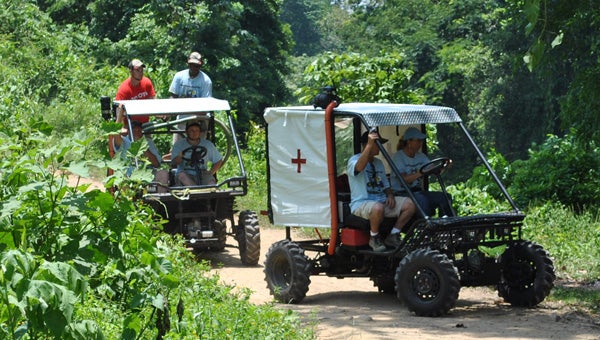Film features Calera High School students’ work in Honduras
Published 4:19 pm Friday, November 8, 2013

Calera High School students donated two basic utility vehicles, which the students made in class, to a free clinic in Honduras, where they are currently being used as a portable freshwater well drill and an ambulance. (Contributed/Teresa Cammack)
By STEPHANIE BRUMFIELD / Staff Writer
CALERA – “Children Changing the World” is a fitting title for the documentary that features a group of Calera High School engineering students.
In the summer of 2012, these students, led by their teacher Brian Copes, traveled to Honduras and literally changed a community’s way of life by giving away free prosthetic limbs and donating two basic utility vehicles to be used as an ambulance and portable freshwater well drill.
“I can’t even estimate what a gift that is,” said Evelyn Castellar, who has run an all-free clinic in the town since 2002.
“Children Changing the World,” which was filmed by Magnolialand Entertainment, debuted for the first time Nov. 7 at the AmStar Theater in Alabaster. The film chronicles Copes’ role as a teacher since 2006 in challenging students to come up with creative solutions to design and manufacturing problems.
In 2006, when Copes was still teaching at Chelsea Middle School, he challenged his students to create a car from scratch, and he eventually entered the students’ design into the Indiana Innovation Awards contest, where they were the only non-collegiate team in attendance.
“When they won, they were introduced as Chelsea University,” Copes said. No one could believe that middle school students had done what they did, and the same is true for the work that has been done by students at Calera High School.
Copes and his students moved from cars to prosthetics after they were visited by a prosthetics specialist, who explained the need for low-cost prosthetics in developing countries. The expert said the cheapest prosthetics available cost $2,000, and they weren’t made for walking long distances.
The first year the students made a prosthetic limb, they made it completely out of Toyota Corolla parts. It worked, but it was heavy, weighing in at a whopping nine pounds, Copes said.
The next year, he challenged his students to improve it, so they exchanged parts for the adjustable part of a crutch, which shaved off three pounds and allowed the limb’s height to be adjusted to fit the person.
Of the 14 prosthetic legs that were given away in Honduras in 2012, the documentary’s producer James Deward Chambliss remembers one vividly, which he recounts in the film. With tears running down her face, a young lady being fitted with a prosthetic told Chambliss, “I’ve been without a leg since I was 7 years old. Every time I had a growth spurt, I had to get a new leg … It was like I lost my leg all over again.”
Speaking of her new leg made by the students, she said, “It grows with me.”
The students were also able to significantly reduce the cost. When UAB students replicated the students’ design using more common materials such as plastic and rubber, they determined the material cost of the prosthetic to be $5.
But the film isn’t just about prosthetics, nor is the students’ work. The film also shows the students riding in basic utility vehicles with Castellar, driving through rivers and rugged terrain to bring medical supplies and treatment to the “Cloud Forest” people, or the largely-impoverished people who live high in the mountains.
The film also shows students drilling fresh water wells, which Castellar says is invaluable because of the scarcity of clean water.
Next in line for the students is another trip to Honduras, which they plan to go on this summer. While there, they plan to bring electricity to the town by setting up a hydroelectric power plant, which they built by cutting a hole in the center of a pontoon boat and placing a six-foot paddle wheel in its place. Copes said the pontoon boat is important because the river running through the town will rise 10 feet in the rainy season, so the apparatus will rise with it.
With the help of Alabama Power, the boat will also feature solar panels to provide power during the dry season.
“In 2006, when I challenged my students to become modern day Henry Fords, it was more than I ever expected,” Copes said. “It’s such an honor as a teacher to have my students recognized in this way.”
The group is still looking for 10 businesses to sponsor students at $4,000 apiece for their trip to Honduras.
“We can’t offer you a whole lot,” said Copes at the Nov. 7 premiere. “But you’re going to change lives.”
The film was also shown at Calera High School Nov. 8 at 10:30 and 11:35 a.m., and Chambliss said he expects to continuing showing the film as he receives feedback.









